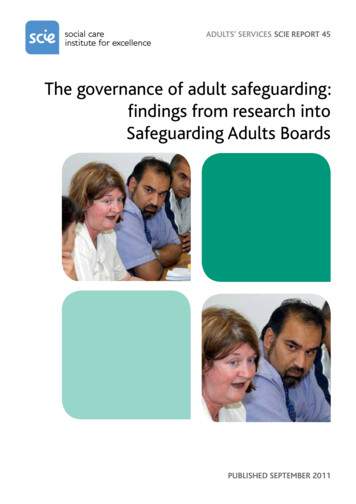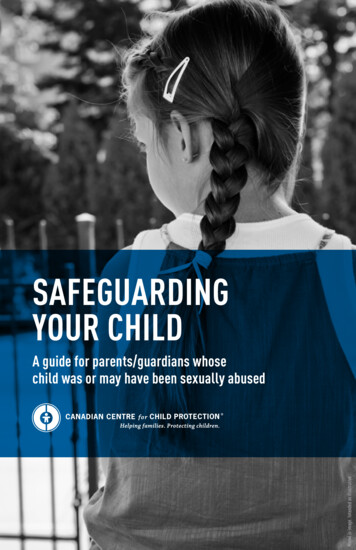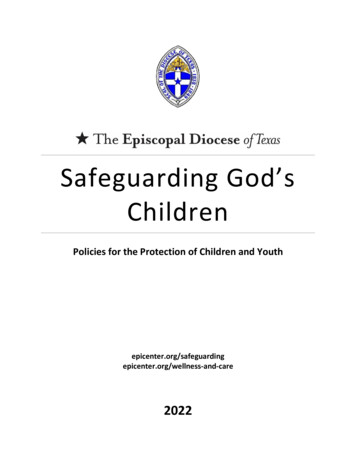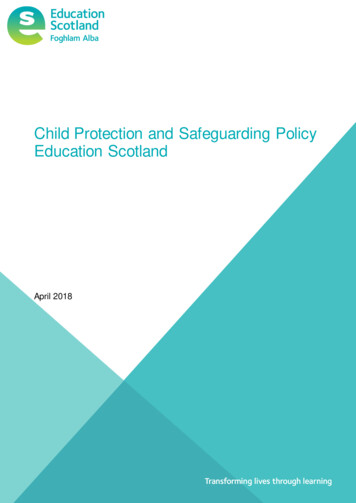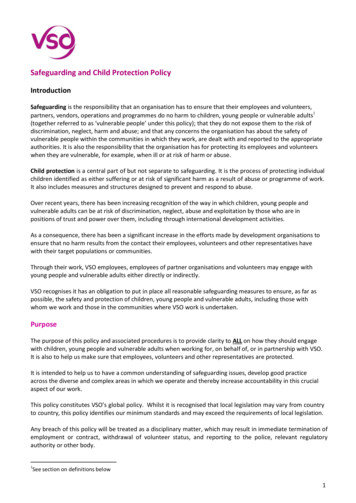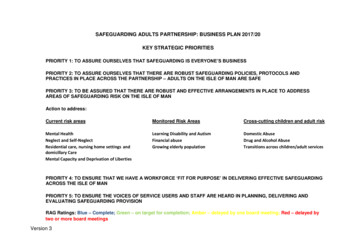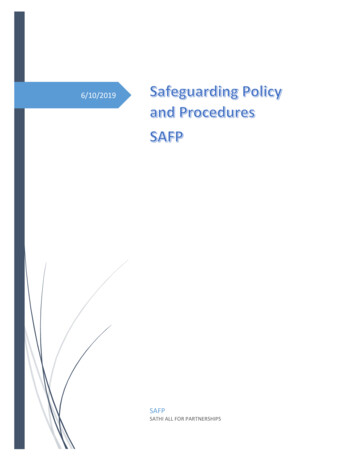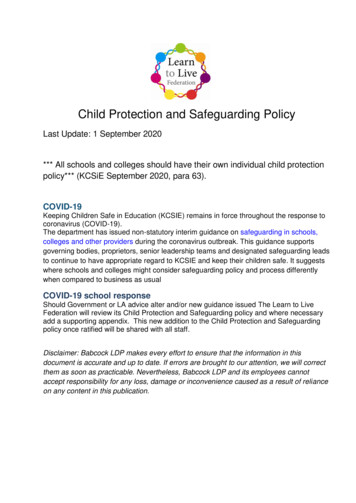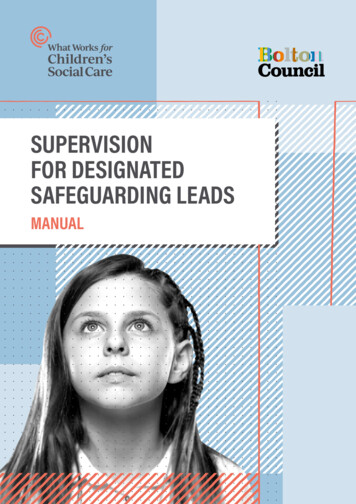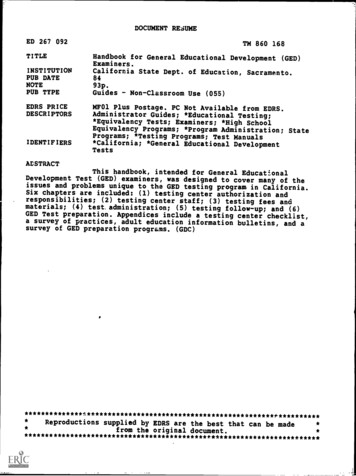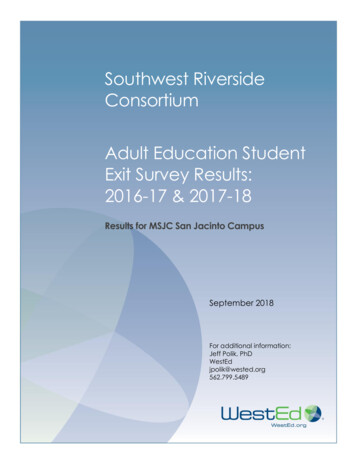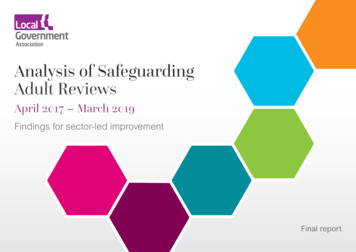
Transcription
Analysis of SafeguardingAdult ReviewsApril 2017 – March 2019Findings for sector-led improvementFinal report
This report was commissioned by CHIP - the sector-led Care and Health Improvement Programme,co-produced and delivered by the Local Government Association and the Association of Directorsof Adult Social Services in England.AcknowledgementsAuthors: Michael Preston-Shoot, Suzy Braye, Oli Preston, Karen Allen and Kate Spreadbury.Project Oversight: Adi Cooper, Care and Health Improvement Programme.
Contents1. Introduction2. Methodology3. SAB Governance of SAR Decision Making4. The Cases5. Themes and Recommendations6. Good Practice7. Poor Practice8. SAR Recommendations9. National Legal and Policy Context10. Conclusions and Reflections11. Sector-Led Improvement PrioritiesAnnex A: GlossaryAnnex B: Data Collection Framework Tool3
1. IntroductionThis report presents the findings of the first national thematic analysis of published and unpublished safeguarding adult reviews (SARs) in Englandsince implementation of section 44, Care Act 2014. Hitherto, in place of a national overview, messages from SARs for sector-led improvement havebeen derived from regional analyses and from research studies that have focused on specific types of abuse and neglect.Thus, thematic reviews have been commissioned by the London Safeguarding Adult Board (SAB)1, by South West ADASS2 and the East MidlandsSafeguarding Adult Network3, which enable analysis of SARs by type of abuse and neglect. More recently a review has been conducted of learningfor the police from SARs4. Thematic reviews that focus on specific types of abuse and neglect have also been published, for example on selfneglect5 6, homelessness and rough sleeping7, modern slavery8, financial abuse9 and alcohol-related deaths10.Since 2015-16, NHS Digital11 has published data giving the number of reviews commissioned in each year, including the numbers of people involved,individuals who died and individuals who suffered harm. However, no breakdown is provided by type of abuse and neglect. The number of reviewscommissioned has risen from 90 in year 1 (2015-16) to 135 in year 4 (2018-19). DHSC funded the establishment of a national library of SARs, hostedby SCIE, which contains reports and summaries provided voluntarily by SABs. However, in the absence of continuation funding, development of thelibrary has stalled; it is incomplete and the search mechanisms are limited.1Braye, S. and Preston-Shoot, M. (2017) Learning From SARs: A Report for the London Safeguarding Adults Board. London: ADASS. 2/London-SARs-Report-Final-Version.pdf2 Preston-Shoot, M. (2017) What Difference Does Legislation Make? Adult Safeguarding Through the Lens of Serious Case Reviews and Safeguarding AdultReviews. Bristol: South West ADASS. ing Review 2017.pdf3 Manson, S. (2017) Report from a Thematic Review of Safeguarding Adults Reviews Within East Midlands. East Midlands 75/emsanthematicreviewsars.pdf4 National Police Chiefs Council – Violence and Public Protection (2020) Learning for the Police from Safeguarding Adult Reviews: Quarter 4 Briefing.5 Braye, S., Orr, D. and Preston-Shoot, M. (2015a) ‘Learning lessons about self-neglect? An analysis of serious case reviews.’ Journal of Adult Protection, 17, 1, 318; Braye, S., Orr, D. and Preston-Shoot, M. (2015b) Serious Case Review Findings on the Challenge of Self-Neglect: Indicators for Good Practice. Journal of AdultProtection, 17, 2, 75-87.6 Preston-Shoot, M. (2016) ‘Towards explanations for the findings of serious case reviews: understanding what happens in self-neglect work’ 18(3) Journal of AdultProtection, 18 (3), 131-148; Preston-Shoot, M. (2017) ‘On Self-Neglect and Safeguarding Adult Reviews: Diminishing Returns or Adding Value?’ Journal of AdultProtection, 19 (2), 53-66; Preston-Shoot, M. (2018) ‘Learning from Safeguarding Adult Reviews on Self-Neglect: Addressing the Challenge of Change.’ Journal ofAdult Protection, 20 (2), 78-92; Preston-Shoot, M. (2019) ‘Self-neglect and safeguarding adult reviews: towards a model of understanding facilitators and barriers tobest practice.’ Journal of Adult Protection, 21 (4), 219-234; Preston-Shoot, M. (2020) ‘Safeguarding Adults Reviews: informing and enriching policy and practice onself-neglect.’ Journal of Adult Protection (forthcoming).7 Martineau, S., Cornes, M., Manthorpe, J., Ornelas, B. and Fuller, J. (2019) Safeguarding, Homelessness and Rough Sleeping: An Analysis of Safeguarding AdultsReviews. London: NIHR and Kings College London.8 Lincolnshire Safeguarding Adults Board (2019).9 Lincolnshire Safeguarding Adults Board (2017).10 Alcohol Change UK (2019) Learning from Tragedies: An Analysis of Alcohol-Related Safeguarding Adult Reviews Published in 2017. London: Alcohol Change UK.11 NHS Digital (2019) Safeguarding Adults Collection (SAC) England 2018-19 Experimental Statistics. t-2018-19-england4
Improvement priority oneThe future of the national library of SARs should be secured, with SABs committed to depositing completed reviews therein, and technology developed to enablereports to be searched more comprehensively.The absence hitherto of a national review of SAR learning has deprived SABs and their partner agencies of an easily recognised pathway by whichthey can locate local learning themes within a national picture. For this reason, the commissioning and now reporting of a national analysis is asignificant and timely development.This national analysis covers all SARs completed between April 2017 and March 2019 inclusive. It was commissioned by the Care and HealthImprovement Programme (CHIP), which provides support to councils in England for social care, integration and health and digital improvement, aswell as supporting the Transforming Care programme for people with learning disabilities and/or autism. It is a sector-led improvement programme forcare and health, co-produced and delivered by the Local Government Association (LGA) and the Association of Directors of Adult Social Services(ADASS) in England and funded by the Department of Health and Social Care.The analysis was commissioned so that the findings can inform sector led improvement in safeguarding adults in England, and the priorities of theadult safeguarding element of the Care and Health Improvement Programme. Accordingly, throughout the report, priorities for sector-led improvementare proposed. They are also collated in the final section of the report.5
2. Methodology2.1. Acquisition of materialsSAB websites were trawled for details and copies of SARs completed within the two-year time period. The SAR library hosted by SCIE was consultedto identify reports logged there that have been completed within the same two-year time period. A second repository12 was also consulted forpublished reviews. A minority of SABs reported that their published SARs had only been made available through the national repository rather than,additionally, through their own websites. By contrast, some SABs either did not have websites or had not updated web pages for some considerabletime, necessitating the use of other data collection methods.SABs were also contacted directly using separate email address lists for Independent Chairs and Business Managers. The request was for copies of,or web links to, all published reviews completed within the two-year time span. This was designed to enable cross-referencing with publishedinformation gleaned from websites, and also to ensure the inclusion of SARs that had not been published on the websites but the details of whichwere nonetheless in the public domain.SABs were also requested to provide copies of unpublished reviews, with the assurance that the confidentiality of this material would be respected.SABs were also asked to provide copies of, or web links to, their published annual reports for each of the two years in question. SAB annual reportsare a viable route for including within the review the details and recommendations of SARs that are not published. Indeed, a minority of SABsreported that summaries of SARs are only published in their annual reports.The definition of ‘completed’ used was that the SAR was accepted and signed off by the SAB within the dates in question. In addition, SABs wereasked to identify any notable reviews falling outside of the two-year time period that they considered to have provided significant and enduringlearning. These have been used in two ways: first, to inform commentary within this analytic report on seminal SARs and SCRs that should remainwithin the collective memory in order to continue to inform future practice; and second, to underscore the significance of particular themes thatemerge from this analysis.Finally, SABs were also asked to comment on any significant changes that have taken place as a result of the SARs they have undertaken during theperiod in question. One significant challenge for SABs is to turn learning and recommendations from SARs into change on the ground. It wasconsidered important therefore to take this opportunity to seek information on impacts that have been achieved.All SABs in England, a total of 132, were approached for this information. 129 SABs responded, representing a response rate of 98 per cent. 29 SABs(22 per cent) had not completed any SARs in the two-year time period for this national analysis. The data collection period ran from March to June2020. Through this process 231 SARs were obtained. Where SABs had decided not to publish either a full report and/or executive summary, theseSARs were shared on the strict understanding that no details would be disclosed in this report that could be attributed directly or indirectly to eitherthe commissioning SAB or the individual and their family. After closure of the data collection period one SAB released for inclusion a SAR that had12https://mhaandmca.co.uk6
not been published. This SAR has been included in the qualitative commentary but not in the quantitative/statistical analysis since this had alreadybeen completed.By cross-referencing the different sources for data collection, it became clear that the returns submitted by some SABs represented an incompletepicture of their review activity. This was sometimes explained as being the result of staffing changes (independent chairs and/or business managers)or new websites necessitated by changes to Board configurations. However, it highlights that SABs must retain an organisational memory and ensureaccurate record keeping, not least to enable partners to track whether SAR findings and recommendations have resulted in ongoing improvements topolicy, procedures and practice.Improvement priority twoSABs should review their record-keeping to ensure that completed SARs remain in the collective memory and available as a baseline againstwhich to measure subsequent policy and practice change.2.2. The analytic frameworkIn order to ensure systematic analysis of the content of each SAR, a four-domain framework was used to map the learning. This has been employedsuccessfully in the London (Braye and Preston-Shoot, 2017), South West (Preston-Shoot, 2017) and East Midlands (Manson, 2017) thematicreviews13.The analytic framework presents learning themes within four domains: direct practice with the individual inter-professional and interagency collaboration organisational features affecting how practitioners and teams worked SAB leadership, oversight and governance.The analytic framework also enabled the collection of data on the characteristics of each case and review. This included: regional location details of the individual concerned, with the framework adapted to account for SARs concerned with more than one person13The approach was first employed by Braye, Orr and Preston-Shoot (2015) in their analysis of SARs featuring self-neglect, with Preston-Shoot continuing to usethat framework in his annual updates of SARs featuring self-neglect (for example, Preston-Shoot, 2019). That approach was itself modified from a framework used inthematic reviews commissioned by the Department for Education: Brandon, M., Sidebotham, P., Bailey, S. and Belderson, P. (2011) A Study of RecommendationsArising from Serious Case Reviews 2009-2010. London: Department for Education.7
details of the case, including type of abuse and neglecttype of review and management of the review process, including impact of parallel processesnumber and type of recommendations.The framework used in previous studies was reviewed and expanded to ensure that it was fit-for-purpose. Part of this development included a pilot toensure that the framework was comprehensive and reliable. Use of the four-domain model ensures that a whole system approach is taken whenidentifying and analysing the learning from the SARs. It is designed to capture good practice as well as learning and recommendations for service andpractice development from less positive outcomes.Finally, to acknowledge the context within which adult safeguarding practice is situated, data was also collected on references in SARs to the nationallegal, policy and financial context. No one location can make sense of its own lived experience without reflecting on the impact of its surroundings.Data was entered through a survey tool that enabled the collection and subsequent collation of both quantitative and qualitative data. This is asustainable tool that can be used for subsequent local, regional and national analyses. It is reproduced as Appendix 1 to this report.Improvement priority threeSABs locally and regionally should adopt the data collection tool as the basis for learning from SARs.2.3. SAR reading and analysisAvailable materials relating to each SAR (full report, executive summary, SAB response, staff briefing and/or annual report summary) were read andthe content used to populate the data collection survey, thus enabling each SAR to be mapped onto the analytic framework described above. Allreviews were read by one person, with a small number initially read by two reviewers in order to check the comparability and reliability of theapproach being taken.Analysis was then carried out through: quantifying and summarising the core information (number of SARs by region, type of SAR, methodology employed, characteristics of theindividuals involved, number and type of recommendations) to provide descriptive statistics on those featuresclose examination and analysis of learning emerging from the process of commissioning, managing and disseminating the outcomes ofSARsclose examination and analysis of SAR learning relating to the four-domains (direct practice, interprofessional/interagency collaboration,organisational features and SAB governance) to identify the patterns and themes emerging and the implications for priorities for the futuredevelopment and improvement of practice.8
The themes emerging from the analysis of SAR learning across the four domains have been compared with those emerging from reviews identifiedby SABs as seminal. Previous reviews undertaken on a thematic or regional basis have also been used as comparative reference points. Thepurpose here has been to identify or reinforce key messages that should endure in the collective memory and to highlight where learning has (not)translated into policy or practice change.A descriptive account has been given of SAB responses on the significant changes that they have achieved as a result of SARs they haveundertaken, with examples where possible. These SAB responses have sometimes been included in their annual reports; sometimes they wereincluded in SAB replies to the request for information for this national analysis. In the face of criticism that reviews result in little effective change14,this part of the analysis explored the evidence of impact and how SABs have addressed the challenge of change15.The SAR quality markers16 have been used as a reference point for evaluating the quality of the SARs reviewed and when commenting on anyreferences to the challenges encountered from commissioning through to completion and dissemination of learning. The quality markers remainincomplete and have not been systematically reviewed since their publication.Improvement priority fourThe SAR quality markers should be reviewed and completed, informed by the findings of this national analysis. After dissemination of the revisedquality markers, SABs should be asked to report on how they have been used to enhance the SAR process.The statutory guidance17 has also been used as a reference point in relation to decision making on what cases to review and how to manage thereview process, disseminate the findings and implement the recommendations. This has enabled conclusions to be drawn regarding the degree ofSAB compliance with the legal rules.2.4. Quantitative AnalysisThe data was collated using a survey tool that provided a mix of structured and unstructured data. This was managed using Smart Survey and asurvey designed for the task of systematising data related to each SAR. Each entry using the data collection tool referred to a single SAR; however,each SAR could relate to several people, who could have been subject to multiple types of abuse in multiple locations. As such, throughout theseanalyses the numbers vary where multiple items have been recorded.The data was further processed resulting in a two-table format:14Wood, A. (2016) Wood report: Review of the Role and Functions of Local Safeguarding Children Boards. London: The Stationery office.Preston-Shoot, M. (2018) ‘Learning from Safeguarding Adult Reviews on Self-Neglect: Addressing the Challenge of Change.’ Journal of Adult Protection, 20 (2),78-92.16 Social Care Institute for Excellence and Research in Practice for Adults (2018) Safeguarding Adult Review Quality Markers Checklist. London: SCIE.17 Department of Health and Social Care (2020) Care and Support Statutory Guidance: Issued under the Care Act 2014. London: The Stationery Office.159
Table 1: Individuals: Containing details of the 263 individuals, some of whom feature in the same SAR.Table 2: Reviews: Containing details of the 231 SARs, including the type of review, methodology, case details, and themes emerging.The analyses in this report are primarily grouped frequencies (ie counts) based on individual or multiple variables. In some instances, whereappropriate, statistical analyses have been conducted. These are explained in the text.Where comparisons are made to national data (for example, national and regional section 42 enquiries), data has been sourced from NHS Digital andrefer to the 2017/18 data returns. Although this timeframe does not exactly match with the timeframe for SARs in the dataset, it is closer than otheravailable national returns. Nonetheless, it should be treated as a comparison for context, and not a matched control group.Tables have primarily been used to display data summaries and sorted for ease of interpretation. However, in some cases where there are multiplevariables or more complex data summaries, figures are given and labelled accordingly. In most instances, data is split by geographic region of theSAB that commissioned / carried out the SAR. It should be noted that some regions have significantly fewer SARs than others, and that care shouldbe taken in interpreting findings where sample sizes are low. For instance, a finding that the majority of cases in a region involve physical abuse ismore likely to represent chance when a region only has a few SARs compared to when the sample size is larger. Conditional highlighting is used inseveral tables to assist with interpretation. Highlighting by columns is done in green (the highest value per column in the darkest shade) and by row inred. For example:Column-wise formatting:Column A Column BRow A52Row B101Row-wise formattingColumn A Column BRow A52Row B101Data processing, cleaning, and subsequent analysis and visualisation have been completed using the R programming language and Microsoft Excel.Full R scripts for the analyses are available.2.5. Statistical terms used in this documentSimple definitions of the statistical terms and tests in this document are provided below18. 18Counts (n): N values are used to denote the number of observations or frequencies in a given group (eg number of people in an agecategory).These are by no means full mathematical explanations and further reading on each definition can be found in statistical texts and online.10
Mean: The average of all numbers in a dataset, calculated by adding all numbers and dividing by the number of observations (the ‘arithmeticmean’).Median: The middle number in a dataset if all numbers were lined up in ascending order.Standard deviation (Std Dev): The dispersion of a dataset relative to its mean, calculated as the square root of the variance (measure ofdifference between each observation and the mean). If the data points are further from the mean, there is a higher deviation within the dataset; thus, the more spread out the data, the higher the standard deviation.Analysis of variance (ANOVA): A statistical comparison of the mean values between two or more groups which considers the mean andvariance of data on numeric outcomes. For instance, the difference in age between men and women.2.6. ReportThis report presents the findings of the analysis that has been undertaken. Specifically, it: sets out the descriptive statistics relating to core information about the SARs included within the analysisreports on the thematic analysis of key learning relating to the four domains, illustrating both good practice and practice that requiredimprovement in the SARs analysed, where relevant including human stories drawn from the SARs to illustrate key messagescomments on the extent to which equality and diversity emerged clearly within the learning themes generated by the analysisexplores similarities and differences between the findings of the analysis and the findings of previous thematic reviews of SARsreports on the enduring learning from seminal SARsreports on significant changes that SABs have achieved as a result of SARs they have conductedprovides commentary on the processes of commissioning and conducting SARs, with reference to the SAR quality markers, to identify anyemergent model of good governance in this fieldconsiders how this learning can inform national priorities for development and improvement and makes recommendations for sector-ledimprovement and for how the Care and Health Improvement Programme can support local implementation of change.So, the report focuses on learning from SARs with respect to the review process itself as well as what may be learned about working with differenttypes of abuse and neglect. It looks forward and anticipates how development and improvement priorities can build on this consolidated body ofevidence, and so inform sector-led improvement in adult safeguarding.2.7. Review team contributionsThis national analysis has been a team effort. The acquisition of SARs was mainly undertaken by Karen Allen (KA) and Michael Preston-Shoot (MPS)with support from Suzy Braye (SB) and Kate Spreadbury (KS). The original template into which data would be recorded was developed by SB andMPS but was developed and expanded for this project in consultation with Oli Preston (OP) and KA. It was further refined after SB, MPS and KS haddiscussed the experience of data input following a pilot. SB, MPS and KS read the SARs and completed data input. OP and KA analysed thequantitative data and wrote those sections of the report. SB and MPS analysed the qualitative data and wrote those sections of the report. The entireteam discussed and agreed the final report.11
3. SAB Governance of SAR Decision Making3.1. Understanding the mandateThe overarching objective of a SAB is to assure itself that local safeguarding arrangements and partners are effective in helping and protecting adultsat risk of abuse and neglect19 20. SABs are under an absolute duty to conduct a SAR where an adult with care and support needs has died as a resultof abuse and/or neglect, including self-neglect, whether known or suspected, and there is concern that partner agencies could have worked moreeffectively to protect the person. There is a comparable absolute duty where the person has experienced serious abuse and/or neglect but survived.In these circumstances there is no discretion; a review is mandatory.Serious abuse and/or neglect is defined as including where the person would have died but for intervention, or where they have experiencedpermanent harm or reduced capacity or quality of life21. In line with Making Safeguarding Personal, it is important to observe that the statutorydefinition of serious abuse and/or neglect is not tightly delineated and, therefore, due regard should be given to how a survivor views what they haveexperienced. The impact of abuse and neglect can include fear, shame, trauma, suicidal ideation, self-neglect, mental health and/or acute hospitaladmission, substance misuse, poverty and homelessness. The person does not need to have been in receipt of services as a result of their care andsupport needs22.SABs may also commission reviews in any other situations involving adults with care and support needs23. Such reviews are discretionary.Not all SABs appear to have grasped the distinction between mandatory and discretionary reviews, or between the absolute duties in sections 44(1),(2) and (3) Care Act 2014 and the discretionary duty within section 44(4). There were references to a review being “non-statutory” or genericdescriptions of referrals “not meeting the criteria” or “the threshold” for a SAR. The quantitative data below illustrates this observation. Greaterprecision is needed, which might be termed legal literacy, in order to ensure that decision making is defensible if ever challenged.Type of abuse can be contrasted against the reason for initiating the SAR and whether there was a legal mandate. This highlights that the majority ofSARs were the result of a section 44 legal mandate. It also raises the question as to what mandate a SAB was relying on to review a case if notsection 44 Care Act 2014.19The adults in question are those described in section 42(1), Care Act 2014.The SAB’s assurance role is set out in statutory guidance: Department of Health and Social Care (2020) Care and Support Statutory Guidance: Issued under theCare Act 2014. London: The Stationery Office (sections 14.133 and 14.139).21 Section 44(1), section 44 (2) and section 44(3), Care Act 2014; Department of Health and Social Care (2020) Care and Support Statutory Guidance: Issued underthe Care Act 2014. London: The Stationery Office (sections 14.162 and 14.163).22 Section 44(1), Care Act 2014; Department of Health and Social Care (2020) Care and Support Statutory Guidance: Issued under the Care Act 2014. London: TheStationery Office (section 14.165).23 Section 44(4), Care Act 2014. Department of Health and Social Care (2020) Care and Support Statutory Guidance: Issued under the Care Act 2014. London: TheStationery Office (section 14.163).2012
13
Improvement priority fiveSABs and their partner agencies should review their shared understanding of the relevant legislation regarding referral and commissioning of SARsto ensure this accurately reflects the absolute and discretionary duties within section 44, Care Act 2014.The quality markers24 do remind SABs to ensure that referrals state which of the statutory criteria are met and that the rationale for decision making isclear and defensible by reference to the Care Act 2014. There were examples of SARs where the review was explicitly described as discretionarybecause the cause of death was not related to abuse and/or neglect, or it was uncertain whether the individual had care and support needs, butwhere learning could be derived from how services worked together. Such reviews were termed variously as learning lessons reviews, managementcase reviews, multiagency reviews or partnership reviews.The Local Government and Social Care Ombudsman’s (LGSCO) remit extends to investigating complaints about how SABs and partner agencieshave managed the SAR process. The LGSCO may investigate terms of reference, outcomes of a SAR, the administrative support given to a review,family involvement, and conflicts of interest. Sometimes no fault has been found in decision making regarding whether to carry out a safeguardingreview25. In another case, no fault was attributed to either the local authority or the SAB26. On occasion the LGSCO has judged that a SAB was betterplaced to investigate the handling of a case, with a SAR being the preferred route27.However, SABs have been reminded of the importance of sound governance. In one case, no fault was found in the decision not to commission aSAR but the SAB was criticised because of the confusion that had been created whilst decisions were being made28. One SAB has been remindedthat decision making on whether or not to undertake a SAR must follow the requirements of statutory guidance29.There are administrative law standards for decision making30. Amongst these standards, decision making must be lawful and reasonable, takingaccount of all relevant considerations. Discretion must not be fettered through the application of blanket policies and reasons must be given for thedecisions reached. In their contributions to this national analysis, one SAB commented that “many SABs might not have commissioned a review ofsuch a case”. Another SAB referred to its “thresholds for a SAR” and expressed the view that some of their reflective reviews may have been SARs inother areas. Yet another SAB
Protection, 19 (2), 53-66; Preston-Shoot, M. (2018) 'Learning from Safeguarding Adult Reviews on Self-Neglect: Addressing the Challenge of Change.' Journal of Adult Protection, 20 (2), 78-92; Preston-Shoot, M. (2019) 'Self-neglect and safeguarding adult reviews: towards a model of understanding facilitators and barriers to best practice.'
